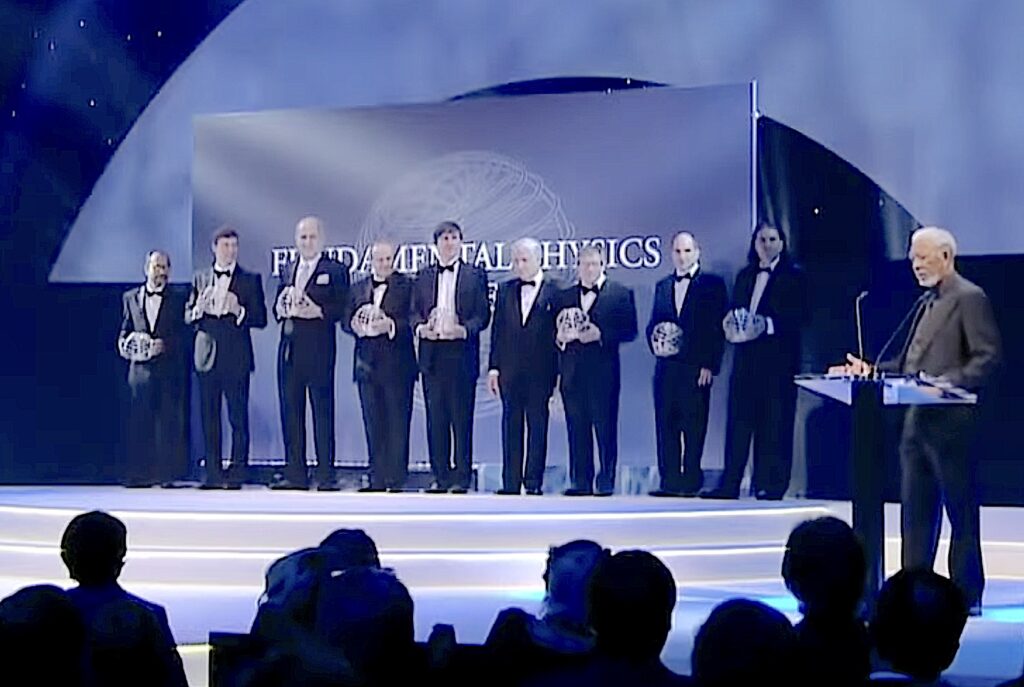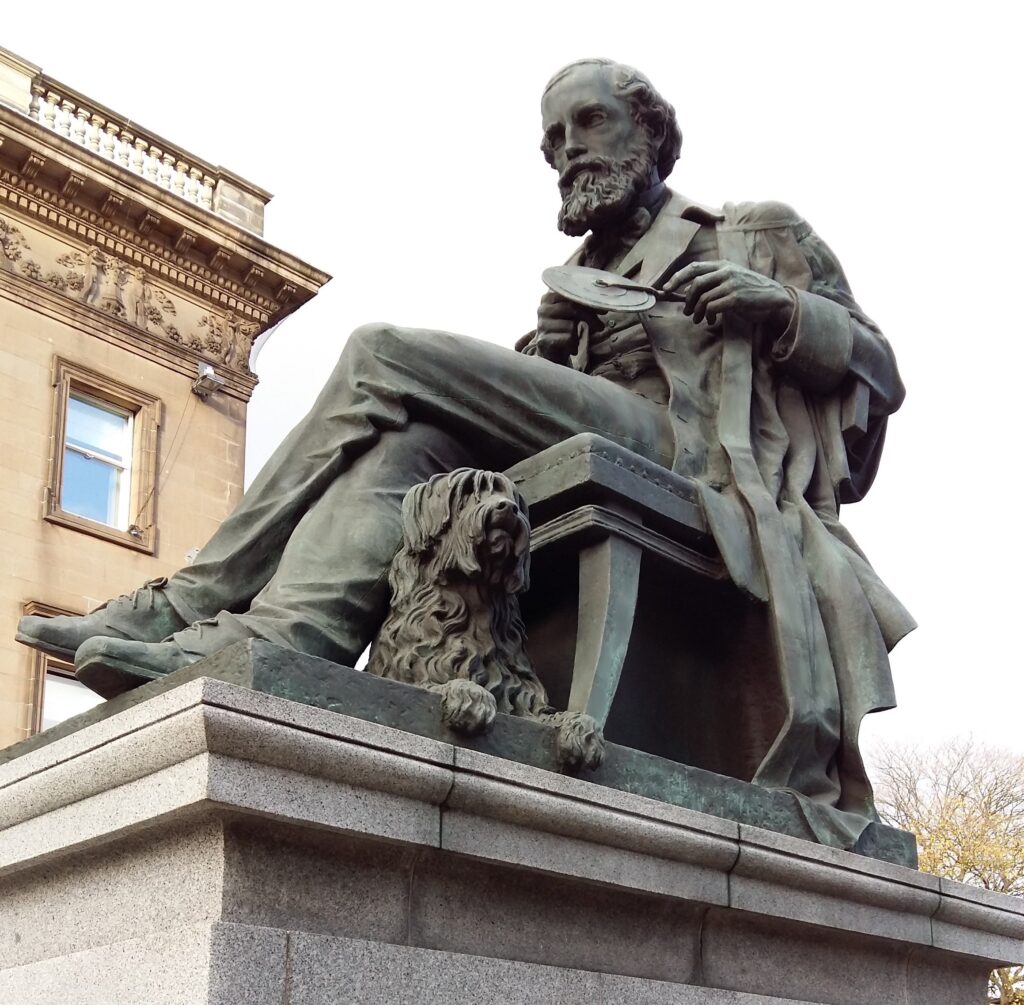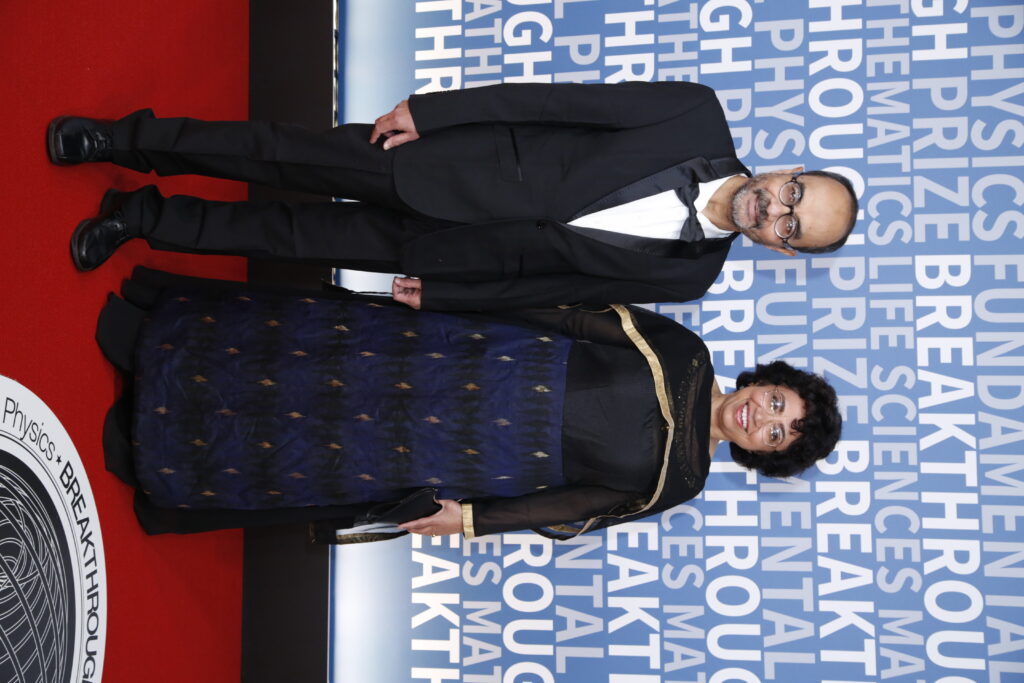
This article is a quick introduction to Ashoke Sen’s scientific achievements, and in addition, contains some discussion of his S-duality proposal and the Sen conjecture, which fetched him the Fundamental Physics Prize.
Citation of the Fundamental Physics Prize
The year 2012 marks the beginning of the Fundamental Physics Prize founded by Russian entrepreneur Yuri Milner. In the inaugural year the Foundation announced a list of nine recipients for their outstanding contribution to various disciplines in theoretical physics. As per their website, https://breakthroughprize.org,
The Breakthrough Prize in Fundamental Physics is given annually for accomplishments in fundamental physics broadly defined, including advances in closely related fields with deep connections to physics.
Ashoke Sen, a professor at the Harish-Chandra Research Institute, Allahabad,1 India is one of the nine recipients of this Prize. The citation for which he is awarded this prize (as stated on the website) says that:
[Ashoke Sen is awarded the Fundamental Physics Prize] for uncovering striking evidence of strong-weak duality in certain supersymmetric string theories and gauge theories, opening the path to the realization that all string theories are different limits of the same underlying theory.
Other recipients of the Fundamental Physics Prize are: Nima Arkani-Hamed, Juan Maldacena, Nathan Seiberg, Edward Witten all from Institute for Advanced Study, Princeton, USA, Alan Guth from MIT, Boston, USA, Andre Linde from Stanford University, Stanford, USA, Alexei Kitaev from CalTech, Pasadena, USA and Maxim Kontsevich from IHES, France. It would perhaps be appropriate to say that the Fundamental Physics Prize has become prestigious solely due to the stature of these inaugural recipients.

Certainly each of these recipients is a stalwart in his field of interest but it will not be an exaggeration to say that Ashoke Sen being one of the recipients has given further credence to the Prize. It is not because he is the only Indian in the list of recipients but because of his phenomenal achievements in string theory. He has been spearheading several new developments in string theory for over two decades.

As mentioned above, Sen received this award for his work on strong-weak duality (also known as S-duality), which he did in the early 1990s, with a definitive evidence for such a duality being provided by him in February 1994. In addition to this, some of his pioneering works include, formulation of string theory in background fields, classification of conformal field theories, string field theory (for open strings as well as closed strings), tachyon condensation, and an enormous body of work on developing understanding of a class of black holes in string theory. Clearly it would be impossible to even give a flavour of some of these works in this article. We will therefore restrict ourselves to a discussion of S-duality, the work cited for the Prize. However, I cannot resist giving a not-so-brief account of Ashoke Sen’s academic timeline!
Tracing Academic Worldline
Ashoke Sen studied up to his matriculation in Sailendra Sircar Vidyalaya in Calcutta (Kolkata). He obtained his Bachelor of Science (BSc) degree from Presidency College, Calcutta. He then joined the Indian Institute of Technology, Kanpur, where he got his Masters degree in Physics. After that, he went to the State University of New York, Stony Brook, USA (now Stony Brook University) to pursue his PhD. Here he worked under the guidance of George Sterman, who had then just joined the Institute for Theoretical Physics, Stony Brook, as a faculty and was working on QCD,2 the theory of strong interactions. Sen worked on QCD during his PhD, which was entirely based on work done all by himself. I believe his first work, an 80-page manuscript on `Asymptotic behaviour of the Sudakov form-factor in QCD’, by itself was good enough to fulfil the requirement of a PhD degree. It was a thorough study of a certain class of logarithmic corrections in QCD, whose importance was better appreciated by the QCD community almost a decade later.
Sen then took up a post-doctoral position at Fermilab, Batavia, USA. During this period he worked on a variety of subjects and wrote about 23 papers within a span of three years. This, in my opinion, was more of an exploratory period during which he worked on QCD, magnetic monopoles and their implications on proton stability, grand unified theories, supergravity, and string theory, which he worked on towards the end of his stay in Fermilab. His pioneering work on `The heterotic string in arbitrary background field’ was just the declaration of his arrival in the field of string theory. After completing his post-doctoral position at Fermilab he joined SLAC (Stanford Linear Accelerator Center), Menlo Park, USA where he spent a little more than two years. This was another period of prolific work but was quite unlike that in Fermilab. By now he had made up his mind to work in string theory and all his 20 publications from SLAC are on various aspects of string theory. While several of them are important contributions, conditions on space-time supersymmetry on the heterotic string compactifications and analysis of various issues in string perturbation theory have had a lasting impact on the field.
After spending two years at SLAC, Sen joined the faculty of TIFR at Mumbai. His work in TIFR can be broadly classified into three parts:
- Study and classification of rational conformal field
theories; - A large body of work on string field theory;
- Duality symmetries in string theory.
It is the programme of studying duality symmetries, which fetched him the Fundamental Physics Prize. There are different kinds of duality symmetries in string theory. It may seem odd to use both duality and symmetry at the same time; however, string theory has certain interesting properties due to which a single phenomenon has two descriptions. These dual descriptions are not distinguishable for a low energy observer. Among a variety of dualities, strong-weak duality is one that is more difficult to understand. This is because it relates a weakly coupled theory to a strongly coupled theory. While one has better control over computations in the weakly coupled theory, computations in the strong coupling limit are notoriously difficult. We will see below the trick employed by Ashoke Sen, of studying a special class of states, called the BPS (Bogomol’nyi–Prasad–Sommerfield) states, to gain insight into this symmetry.
After spending about seven and a half years in TIFR, Ashoke Sen moved to Harish-Chandra Research Institute (HRI) (at that time known as Mehta Research Institute of Mathematics and Mathematical Physics), Allahabad. His work on duality symmetries in string theory had just led to what is now called `the second superstring revolution’. However, change of location had no adverse impact on research output. For example, some of his early works in HRI are now known as `The Sen limit of F-theory’, `The Sen four manifolds’ and `Sen–Seiberg definition of Matrix theory’. Although he was the one who convinced the string theory community to pay attention to the spectrum of BPS states, he started focussing his attention on non-BPS states! In a series of papers on tachyon condensation and non-BPS states, he convinced the community that there is more interesting physics hidden there, just when most of the community had barely begun to appreciate the importance of BPS states. The work on tachyon condensation and its understanding in terms of a new formulation of string field theory was followed by another big programme of understanding entropy of a special class of black holes in string theory. A programme which is still being pursued!3
S-duality
We now focus our attention on the S-duality. Before we get into the technical details let us take a semi-technical tour of the implications of S-duality. Action of the S-duality transformation takes us from a strongly coupled description of one theory to a weakly coupled description of another theory. A coupling parameter in a theory is a measure of how constituents of the theory interact with each other. If this parameter is small, then constituents are weakly interacting but if this parameter is large, then they are strongly interacting. There are techniques like perturbation theory which give reliable results if the coupling parameter is small, or equivalently if the theory is weakly coupled, but this technique fails miserably if the theory is not weakly coupled. If S-duality transformation related a strongly coupled theory to some other theory which is weakly coupled, then results of the strongly coupled theory could be obtained by employing perturbation theory to the dual weakly coupled description. To show that S-duality gives us this dual description, one needs to show that the physics of the original (strongly coupled) description and the dual (weakly coupled) description is identical. Since there are no controlled techniques of doing computations in the strongly coupled theory, establishing such an equivalence is no simpler than actually solving the strongly coupled theory. The trick here is not to give the proof of S-duality, for it would require solving both strongly coupled theory and weakly coupled theory exactly and showing that the results match, but to provide unequivocal evidence of it.
Sen provided this crucial evidence by highlighting the fact that the spectrum of a class of states, known as the BPS states, in certain supersymmetric theories does not change as we change the coupling parameter such that the theory changes from weakly coupled to strongly coupled. This result provided the evidence that the theory considered by Sen gets transformed into itself under S-duality transformation. His result led to a flurry of activity in understanding implications of S-duality in various theories and in many examples it was shown that S-duality maps the strong coupling limit of one theory to the weak coupling limit of a different theory. The most important and interesting implication of S-duality was found in string theory. Before the S-duality, there were five different superstring theories and an eleven-dimensional supergravity, but S-duality combined with other duality symmetries of string theory showed that these five string theories and the eleven-dimensional supergravity are different `weak coupling limits’ of a single master theory, the M-theory. After gathering a reasonable amount of evidence of S-duality relation between two theories, one can assume such a relation to be true and explore its implications and determine the physics of strongly coupled systems. Clearly the number of possibilities are unlimited.
We will now get into more technical details of S-duality. To understand S-duality, we need to prepare some background. Let us start with classical electrodynamics, i.e., with Maxwell’s equations.
\[ \begin{eqnarray}
\vec{\nabla}\cdot\vec{E} & = & \rho,\\
\vec{\nabla}\cdot\vec{B} & = & 0,\\
\vec{\nabla}\times\vec{E} & = & – \frac{\partial\vec{B}}{\partial t},\\
\vec{\nabla}\times\vec{B} & = & \vec{J} + \frac{\partial\vec{E}}{\partial t},
\end{eqnarray}\]where \vec{E} is the electric field, \vec{B} is the magnetic field, \rho is the electric charge density and \vec{J} is the electric current density. If we compare (1) and (2), it is easy to see that on the right-hand side of (2) we do not have magnetic charge density. It implies that there is no magnetic analog of electric charges and consequently no magnetic current density in (3). This is also equivalently stated as: There are no magnetic monopoles in nature.
It is, however, interesting to note that in the absence of electric charges, Maxwell’s equations look quite symmetric.
\[ \begin{eqnarray}
\vec{\nabla}\cdot\vec{E} & = & 0,\\
\vec{\nabla}\cdot\vec{B} & = & 0,\\
\vec{\nabla}\times\vec{E} & = & – \frac{\partial\vec{B}}{\partial t},\\
\vec{\nabla}\times\vec{B} & = & \frac{\partial\vec{E}}{\partial t},
\end{eqnarray}\]They are invariant under the so-called electric-magnetic duality transformation,
\[ \begin{eqnarray}\vec{E} \rightarrow \vec{B} \quad {\rm and} \quad \vec{B} \rightarrow -\vec{E}.\end{eqnarray}\]Thus in free space, i.e., in the absence of both electric and magnetic sources, electric-magnetic duality transformation is a symmetry of Maxwell’s equations. However, this symmetry is explicitly broken in the presence of electric sources. It can be formally restored if we postulate the existence of magnetic monopoles, which are magnetic analogs of electric charges. Precisely this, was proposed by Dirac in 1931, and hence goes under the name `Dirac monopole’.
Let us look at the consequences of Dirac’s proposal. To understand Dirac’s proposal, let us first consider a simpler situation of an electric field generated by a point electric charge e situated at the origin of three-dimensional space. This can be deduced by solving (1) with \rho = e\delta(\vec{r}), where \delta(\vec{r}) is the Dirac \delta-function which ensures that the charge is located at \vec{r} = 0, which is the origin of three-dimensional space. The solution is given by
\[ \begin{eqnarray}\vec{E} = \frac{e\vec{r}}{4\pi r^3}. \end{eqnarray}\]Let us now assume that, like the electric charge e, we have a magnetic charge g. The magnetic field generated by this magnetic charge is
\[ \begin{eqnarray}\vec{B} = \frac{g\vec{r}}{4\pi r^3}. \end{eqnarray}\]
\[ \begin{eqnarray}m \frac{{\rm d}^2\vec{r}}{{\rm d}t^2} = e\vec{v}\times\vec{B} = \frac{eg}{4\pi r^3}\frac{{\rm d}\vec{r}}{{\rm d}t}\times\vec{r}, \end{eqnarray}\]where \vec{v} is the velocity of the electrically charged particle. We will now determine the change in the orbital angular momentum of the charged particle due to the magnetic field generated by the magnetic monopole. The orbital angular momentum is given by
\[ \begin{eqnarray} \vec{L} = \vec{r}\times\vec{p} = m\vec{r} \times \frac{{\rm d}\vec{r}}{{\rm d}t}. \end{eqnarray}\]The change in the orbital angular momentum is computed by studying the time variation of \vec{L},
\[ \begin{eqnarray} \frac{{\rm d}\vec{L}}{{\rm d}t} = m\vec{r} \times \frac{{\rm d}^2\vec{r}}{{\rm d}t^2} = \frac{eg}{4\pi r^3}\vec{r}\times\frac{{\rm d}\vec{r}}{{\rm d}t}\times\vec{r} = \frac{{\rm d}}{{\rm d}t}\left(\frac{eg\vec{r}}{4\pi r} \right) \end{eqnarray}\]This implies that the conserved angular momentum of the charge-monopole system is
\[ \begin{eqnarray} \vec{J} = \vec{L} – \frac{eg\vec{r}}{4\pi r}. \end{eqnarray}\]In classical mechanics, we can set this result aside as an interesting curiosity of the charge-monopole system, but in quantum mechanics, it leads to profound consequences. In quantum mechanics, angular momentum is quantized. The change in the angular momentum effected by the monopole also has to satisfy this quantization rule,
\[ \begin{eqnarray}\frac{eg}{4\pi} = \frac{1}{2}n\,\hbar, \end{eqnarray}\]where \hbar is the Planck’s constant. This is known as the Dirac quantization condition. An immediate consequence of this result is quantization of the electric charge due to the presence of the magnetic monopole. Equation (16) can then be interpreted as follows. If the magnetic monopole of charge g exists in nature, then all electric charges are quantized in units of 2\pi \hbar/g. In other words, only electric charges which are integer multiples of 2\pi \hbar/g are quantum-mechanically well defined in the background of a magnetic monopole of charge g.
The Dirac quantization condition can be used to understand how electromagnetic fields would interact with a magnetic monopole. If we consider the motion of a free particle in three dimensions, we write the Hamiltonian as
\[ \begin{eqnarray} H_{\rm {free}} = \frac{(\vec{p})^2}{2m}, \end{eqnarray}\]where \vec{p} is the momentum of the particle of mass m. If this particle has a charge e and it couples to the background electromagnetic field, then the Hamiltonian takes the form,
\[ \begin{eqnarray}H_{{\rm em}} = \frac{(\vec{p}-e\vec{A})^2}{2m} + eA_0, \end{eqnarray}\]where \vec{A} is the electromagnetic vector potential and A_0 is the Coulomb potential, which, from now on, will be set to zero just for ease of presentation. Notice that coupling of the charged particle to the electromagnetic field is proportional to e, which we will refer to as the electromagnetic coupling constant. If we carry out the same procedure for a particle carrying magnetic charge instead of electric charge, then we will write the Hamiltonian as (18) with e replaced by g and the vector potential \vec{A} replaced by the dual vector field \vec{\tilde{A}}. We can thus write the Hamiltonian for a particle with magnetic charge,
\[ \begin{eqnarray} H_{\rm {dual}} = \frac{(\vec{p}-e\vec{A})^2}{2m} = \frac{1}{2m}\left(\vec{p} – \frac{2\pi n\hbar}{e}\vec{\tilde{A}} \right)^2, \end{eqnarray}\]where we have used (16) to write the last expression. If we now compare (18) and (19), we see that when electric coupling e is small, magnetic coupling g is large and vice versa. We thus see that when electrically charged particles are weakly coupled, magnetically charged particles are strongly coupled. This implies that if we want to study strong coupling phenomenon for electrically charged particles, weak coupling description in terms of magnetic charges would be most suitable. This is known as the electric-magnetic duality, alternatively also known as the strong-weak duality.
For this duality to work one needs magnetically charged objects to give a dual description of the theory of electrodynamics. Unfortunately no such magnetically charged objects exist in electrodynamics. However, more general theories from which electrodynamics can be derived do admit magnetic monopole solutions. Although they are solutions of more general theories, the Yang–Mills–Higgs theories, they behave exactly like the Dirac monopole in electrodynamics. Thus, if we want to test if strong-weak duality exists, the Yang–Mills–Higgs type theories provide an appropriate arena to set up testable questions and seek answers to them. The problem, in fact, is more difficult than this because even in the Yang–Mills–Higgs system no reliable strong coupling computation can be done to test strong-weak duality. Luckily, there exist theories in which duality can be tested. These theories possess an additional symmetry known as supersymmetry. A detailed description of supersymmetry is beyond the scope of this article. Suffice it to say that it is a symmetry which relates bosons to fermions and vice versa. Although supersymmetry is not observed in nature, it is a very powerful computational tool and plays a pivotal role in gathering evidence for strong-weak coupling duality.
The Sen Conjecture
Sen realized that the power of supersymmetry can be put to good use for testing duality. He showed that if strong-weak coupling duality is a symmetry of a supersymmetric theory then it imposes constraints on multi-monopole solutions. He made a specific conjecture about multi-monopole solutions in the maximally supersymmetric Yang–Mills theory. To understand this conjecture, let us consider an example of motion of two particles in three dimensions. Each particle is parametrized by its location in three-dimensional space. In other words, we need to specify three continuous parameters per particle (or in total six parameters) for completely specifying a two-particle system. If these particles are identical, then their positions are described by six parameters up to exchange (of the two particles). Similarly, for a system of n identical particles, the parameter space is 3n-dimensional up to permutation of n particles. Identical considerations apply to multi-monopole systems, except that each monopole is parametrized by four parameters, three positions and one phase associated with electromagnetic symmetry. This phase also implies that the monopole could carry electric charge, in addition to the magnetic charge. Thus the n-monopole system is parametrized by 4n parameters. Based on the assumption of S-duality symmetry, Sen [1] conjectured that:
For n-monopole system, there exists a unique function which can be integrated on the half dimensional subspace of 4n dimensional parameter space, for every electric charge carried by the system.
He then explicitly constructed such a function for the 2-monopole system [1], providing compelling evidence for S-duality. This conjecture was partly proved later by mathematicians S[1], where they showed the existence of such functions but their uniqueness was not established. This result not only paved the way to understand strong coupling physics of certain supersymmetric theories but also played a pivotal role in `unification’ of various string theories. In fact, the development in string theory triggered by this result is now referred to as `the second superstring revolution’. It would not be an exaggeration to say that most of the subsequent developments in string theory hinged on the understanding of various duality symmetries of string theory.
The Magician

Apparently, the Nobel Laureate Hans Bethe had once said, “There are two types of genius. Ordinary geniuses do great things, but they leave you room to believe that you could do the same if only you worked hard enough. Then there are magicians, and you have no idea how they do it.” Sen is a curious mix of these two types – while he is clearly a magician but with phenomenal logical clarity and mathematical precision, he also (while presenting his results) makes his listeners believe that they could also obtain such results if only they worked hard enough! Despite being one of the world leaders in the field of string theory, Sen is one of the most accessible and an extremely humble person. He is a living example of the following Sanskrit quote4

Branches of a tree laden with fruits bend downwards, likewise true genius is humble.
\blacksquare
References
- [1] Ashoke Sen, Dyon-monopole bound states, self-dual harmonic form on the multi-monopole moduli space, and SL(2,Z) invariance in string theory, Phys. Lett. B, Vol.329, p.217, 1994. [hep-th/9402032].
- [2] Graeme Segal and Alex Selby, The cohomology of the space of magnetic monopoles, Commun. Math. Phys., Vol.177, p.775, 1996.
Footnotes
- Presently at the International Centre for Theoretical Sciences, Bengaluru. ↩
- Editor’s note: Quantum chromodynamics, or QCD, as it is normally called in high-energy physics, is the quantum field theory that describes the strong interactions. ↩
- Author’s updated note: A lot of progress, having direct relevance to black hole entropy, is made in the black hole state counting problem. In 2007, Ashoke Sen pointed out that the dyon counting formula is piecewise constant in the moduli space and identified the walls of marginal stability. In 2008, Kontsevich and Soibelmann made a proposal about what is called the wall crossing formula, followed by a similar suggestion by Joyce and Song. After studying various aspects of these formulae and their relevance to BPS black holes in N=2 supersymmetric string theory, Sen showed that all these formulae are identical. In the N=4 supersymmetric string theory case, it was known that the state counting formula has a denominator given in terms of the Siegel cusp form. Atish Dabholkar, Sameer Murthy, and Don Zagier showed that expansion of this formula on the numerator can be written in terms of mock modular forms. Contextual allusion to how this last bit came about after listening to a talk by Sen is nicely related in the interview with Zagier in Bhāvanā, 7(2), 5–30 (2023). ↩
- Editor’s note: This verse is an extract from Garuda-purana, 1.114.51. ↩
